Being a significant part of the digital landscape, APIs have opened the doors for loads of opportunities, not just as third-party facilitators but also as the driving force behind the enterprise economy. Enterprises that provide external APIs have strategically gone through an economic transformation by monetizing APIs’ operational and functional aspects.
According to Gartner, we need to treat our APIs as products. This way, application leaders will be able to view them from the perspective of new business opportunities and select the optimal course to scale their revenue. This uncharted waters for most business leaders which means it’s a complex challenge to choose the correct monetization strategy. In the past most API initiatives have been focused on cost savings or passive income streams, today it is estimated that up to 30% of enterprise revenue will come from API’s in the next few years.
The concept of API monetization is promising. Indeed, today we’re seeing APIs as business drivers in and of themselves. That said, there are many ways to monetize your APIs, and it goes far beyond simply charging a fee.
This article will quickly look at API monetization and discuss its role and position in the current API market.
What Is API Monetization?
The API economy value chain, as described by IBM, is the pipeline that enables businesses to transform their APIs into revenue channels. The API economy value chain has three important participants.
- API Provider: the API provider is the initiator and probably the most important API economy value chain component. It decides which business routines should be made available to the consumers as APIs, the rate limits, and other terms and conditions.
- API Consumer: the API consumer, in most cases, is a developer or some technical personnel from the engineering that uses these APIs to develop software applications for the end-users.
- End-User: the end-user in the entire API economy value chain is a customer that does not directly interact with the API but consumes it via the software application.
Successful API monetization is when all three parties (API providers, API consumers, and end-users) take full advantage of the APIs. Suppose an API provider wants to charge for using its API, but there are no clear protocols, guidelines, limitations, or costs associated with its usage. In that case, the API consumer is left with an unpleasant experience.
On the other hand, if an API consumer knows exactly about the guidelines and pricing around API consumption, then the developer will undergo a smooth integration experience and ultimately enable the best application experience for end-users.
Apart from the API economy value chain, there are some fundamental questions that one should ask before designing an effective API monetization strategy. IBM’s whitepaper on API monetization discusses in detail these questions and guides on how you can use them to identify the scaling options for your business.
API Monetization Models
Conventionally, API monetization follows four major models to govern the economy in the API space. Take a look at them below.
Free
It is the most basic form of monetization model that the API providers offer. As the name suggests, the “free” monetization model does not charge for the API consumption. Rather it relies on passive revenue streams for running the business and offers high-quality APIs to satisfy and improve the consumer experience.
Consumer Pays
The “consumer pays” monetization model is the most standardized form of monetization option. The providers usually offer freemium subscriptions and gradually advance towards the pay-as-you-go model based on the API consumption patterns. All kinds of rate limitations and subscription up-gradation primarily fall into this category.
Consumer Gets Paid
The “consumer gets paid” monetization model focuses on rewards instead of explicitly charging the consumer for usage. It includes revenue sharing schemes, affiliate marketing, and referral links that encourage developers to consume the APIs and benefit from the shared monetization system.
Indirect Monetization
An indirect monetization model is often recommended when an API provider wants to establish long-term business relationships with the consumers. Using advertisements and other marketing strategies, you can generate revenues and establish frequent interactions with the consumers, which is much better than a single interaction.
With API portal platforms like Apiboost, many brands take indirect monetization a step further, as a majority of API Boost users gate their API Portals and only accept Partners to enter. This gives them the ability to establish different terms with each individual partner.
The Reality of API Monetization
Now is the right time for enterprises to realize that not everything should be monetized. If your vision is to publish APIs for the sake of generating revenue, then in most cases, you are probably not on the right path of scalability and sustainability.
In some cases, the business model and related factors are designed so that it makes the utmost sense to enable APIs to lead the charge in todays enterprise economy. It is highly recommended that you revisit your business model and strategic planning before making the final call of choosing APIs as a source of revenue for your business. For more insights into how to approach your API monetization strategy, we recommend Gartner’s article on the top ten things software engineering leaders need to know about APIs.
Taking Your First Steps Toward API Monetization
API monetization is indeed a nice model to create income streams, but do we really need to do it? The simple answer is, maybe not yet.
As lucrative as the API industry is, we are in fact witnessing the industry in its infancy. Monetization should certainly be explored, but barring a select few enterprises, most companies are still a year or two away from monetizing their APIs, simply because they haven’t built up the reputation or customer-base to do so.
So, what should be done to speed up the process?
Well, every aspect of today's business is more technical. From HR to Marketing to Operations, everyone is tech-savvy or at the very least, tech-aware. If you want APIs to be your key business driver, you need an environment where APIs are accessible to everybody within your organization and partnering organizations — not just the development team.
Modern API portals are making this happen. They are now focused on promoting the products and capabilities of the enterprise. If your portal does not promote APIs as products, it is time for a new portal.
Your API portal should be a quick and easy to access environment for anyone to explore your API offering, seek out documentation, and discuss solutions with the community. When your portal has these redeeming qualities, you can begin to build a community around your APIs, laying the foundations for innovation, collaboration, and revenue growth down the line.
Of course, a fair number of enterprises are already in a position to monetize their APIs directly, and their examples should be followed. Monetizing your APIs could be an easy extension of your product business model. Take Stubhub as an example, they sell event tickets directly and they offer APIs that allow their partners to sell tickets on their sites. This is direct monetization—the type of monetization that’s far easier to do once your in-direct monetization strategies revolving around community, collaboration, and innovation, are all in order.
Paving the Way to Sustainable API Monetization
According to Gartner, by 2025, more than 75% of organizations will directly or indirectly monetize APIs. Successfully monetized APIs demand all the product management attention that any software release would, while enhancing the experience of developers, marketers, and business leaders at the same time.
It’s a tall order for most API vendors, which is why so many are turning to API portal platforms like Apiboost, a SaaS product offering with all the essential ingredients needed to launch an API portal in weeks rather than months.
Apiboost’s out-of-the-box features enable API vendors to optimize collaboration between teams and partners. Companies can build teams through a simple admin interface, allowing team members to collaborate and innovate on apps and products in a group environment. This powerful tool also allows an Product Owner to assign apps and products to departments, partners and customers for effective collaboration while securely exposing your data to only approved team members.
Plus, Apiboost empowers API vendors to optimize the API product. Products and content on the portal can be controlled at a Product Owner level. The Product Owner and his or her Product Staff can manage content associated with products including the description in the catalog, blogs, videos, events and forums. Product Owners can approve/deny key requests and generate emails notifications, giving them complete control over their API offering. Products can also be grouped in a number of ways, including business units, markets, and by region.
Finally, Apiboost stands ready for a multi-tenant approach to API management. As organizations shift toward deploying multiple API Management solutions and gateways, Apiboost can seamlessly connect to GCP, Azure and AWS and display all API's in Teams and Products.
Now that’s what we call an API platform primed for monetization.

 Ron Huber
Ron Huber




